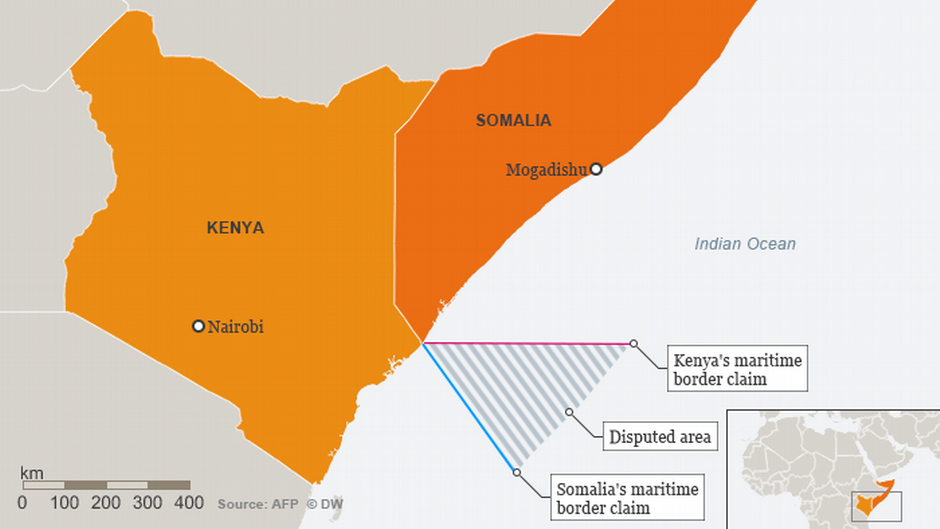Kenya seeks to engage Ethiopia in resolving the issue of a common border with Somalia hoping to use Addis Ababa’s leverage on the President Mohamed Abdullahi Farmaajo of Somalia. However, there are doubts that Nairobi could put forward a proposal to Ethiopia likely to offset Addis Ababa’s political losses in Somalia over fronting for Kenyan interests. Although, hypothetically, the solution of water resources conflict between the two countries, strategically important to Ethiopia, could be an issue.
Ethiopian Prime Minister Abiy Ahmed is a close friend of the administration in Somalia. He has hosted the Somali leader on a number of occasions and has attempted mediation of a maritime rift between the two neighbours. Uhuru Kenyatta believes that Abiy can help in brokering an out of court settlement over the maritime boundary dispute.
Kenya is arguing the sea border should be drawn parallel to the line of latitude, Somalia is saying it should extend in the same direction as its land border.

Somalia, which brought the matter of the border dispute before the International Court of Justice in 2014, had hoped for a ruling in September 2019. But Kenya managed to have ICJ adjourn the case to June 2020. Uhuru Kenyatta insists on a bilateral solution but Mogadishu officials have refused to negotiate with Nairobi. Kenya has tried to convince Somalia to drop the case and settle the matter outside of court. It sees the dispute as an existential threat that is about more than potential oil and gas deposits but its access to the Indian Ocean. The disputed area is believed to be rich in oil and gas deposits.
While the court’s decision is final and binding under international law, it cannot enforce it. ICJ rulings have been ignored in the past and there is no guarantee both parties will accept it.
A verdict in favour of Somalia could, among other things, push Kenya to contest its southern sea border with Tanzania, leading to a destabilizing domino effect of disputes down to Mozambique, Madagascar and South Africa. A verdict in favour of Kenya could damage a fragile Somali state and embolden al-Shabaab which has already said it will never accept, and are against any decision made by the International Criminal Court.
Last August, Kenyan parliamentarians called on President Uhuru Kenyatta to consider sending troops to the maritime border to protect the “sovereignty and territorial integrity of the Republic”. Somali lawmakers suggested they would be prepared to respond in kind.
However, in March 2020 Kenya’s warning to Somalia was connected to armed inroads by Somali federal forces into Kenya’s Mandera county. The Somali forces were engaging with forces of the regional Jubbaland forces when the said incursions into Kenyan territory were recorded.
It is conceivable that the Mogadishu operation in Jubbaland aimed to distract Nairobi and prevent Kenyan troops from being sent to the disputed area.

Mandera County forms the northernmost part of the Kenya-Somalia border. The region is inhabited by the Garre, Degodia, and Murule clans, with the Marehan clan from across Somalia migrating in large numbers over the years of conflict in Somalia. On the Somali side of the border is the Marehan clan. Clans in Mandera county have a physical presence or close clan ties with clans in Somalia. The inter-clan rivalry and conflict, especially the competition between a Garre- Murule alliance and a possible Degodia-Marehan alliance is the factor facilitating Al Shabaab’s attacks.

Escalation in Mandera amid Mogadishu-Jubbaland confrontation requires Nairobi to speed up to calm the situation and prevent al-Shabaab from strengthening its hand.
Kenya has hinted that it could annex parts of Somalia to keep al-Shabab terrorists out of its territory. The situation in the area remains precarious as Jubbaland forces are regrouping for possible fresh clashes, despite efforts to ease the hostility.
Kenya’s buffer zone against al-Shabaab in Somalia is located in Gedo region, extending to the disputed maritime location. Mogadishu believes Nairobi’s actual intention of supporting Jubbaland’s Ahmed Madobe is to continue their presence in that area where there is the disputed maritime space. According to Kenya, deploying troops to Somalia’s Gedo region could stop al-Shabaab fighters from entering Kenya. Kenya accuses Somalis of letting al-Shabaab terrorists infiltrate and recruit suicide bombers from refugee camps for Somalis fleeing war. The terrorists have carried out dozens of attacks in Kenya in a bid to force Nairobi to withdraw its troops from Somalia.
However, Kenya’s interest in Somalia goes beyond stopping al-Shabaab and the oil-rich maritime area. Kenya needs “access to Kismayo port, some level of control of Kismayo port, access to charcoal export from Somalia, that KDF (Kenya Defense Forces) have profited from.
The United States warns that the border dispute tensions could give room to the al-Qaida linked al-Shabaab group, which is now a potent threat to both countries and complicates efforts to end piracy in the Indian Ocean.
Kenya contributes about 4,000 troops to the Africa Union’s peacekeeping mission in Somalia, AMISOM. But Kenya has more than double that amount of non-AMISOM forces deployed in Somalia. If the diplomatic tensions increase further, Kenya could potentially choose to pull its troops from AMISOM. Such a move would be disastrous for Somalia as Kenya is a key contributor and the country does not have a stable and efficient army. Al-Shabaab, which over the years has emerged as a very resilient force, could quickly overrun most regions in southern Somalia, where it still maintains some control.




